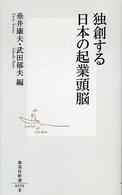- ホーム
- > 洋書
- > 英文書
- > Politics / International Relations
Full Description
The Senate majority and minority leaders stand at the pinnacle of American national government - as important to Congress as the speaker of the House. However, the invention of Senate floor leadership has, until now, been entirely unknown. Providing a sweeping account of the emergence of party organization and leadership in the US Senate, Steering the Senate is the first-ever study to examine the development of the Senate's main governing institutions. It argues that three forces - party competition, intraparty factionalism, and entrepreneurship - have driven innovation in the Senate. The book details how the position of floor leader was invented in 1890 and then strengthened through the twentieth and twenty-first centuries. Drawing on the full history of the Senate, this book immediately becomes the authoritative source for understanding the institutional development of the Senate - uncovering the origins of the Senate party caucuses, steering committees, and floor leadership.
Contents
1. Individual goals and senate party organization; 2. Presiding officer, 1789-1914; 3. Caucus, 1789-1879; 4. Steering Committee, 1856-1913; 5. Arthur Pue Gorman, the Federal Elections Bill, and the invention of Elected Floor Leadership, 1890-1913; 6. Leaders and whips, 1913-1924; 7. Divergent paths and the consolidation of leadership structures, 1923-1944; 8. Party infrastructure, 1945-1980; 9. Polarization, competition, and centralization, 1981-2024; 10. Conclusion; Appendix.







